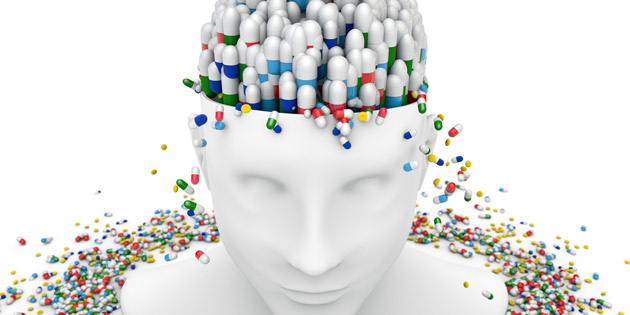 Advances in brain science and the understanding of mental health disorders have led to the approval of new medicines, but mental health disorders still take a huge toll on Americans. The National Institute of Mental Health (NIMH) estimates that one in four American adults — 61.5 million people — have been diagnosed with a mental health disorder. Serious mental illnesses cost the United States more than $317 billion annually in lost wages, healthcare expenditures, and disability benefits.
Advances in brain science and the understanding of mental health disorders have led to the approval of new medicines, but mental health disorders still take a huge toll on Americans. The National Institute of Mental Health (NIMH) estimates that one in four American adults — 61.5 million people — have been diagnosed with a mental health disorder. Serious mental illnesses cost the United States more than $317 billion annually in lost wages, healthcare expenditures, and disability benefits.
There is now an upward trend in research of the brain. But much of that research has been in neurodegenerative diseases, such as Alzheimer’s and Parkinson’s, and in neurodevelopment disorders such as attention deficit disorder. Mental health has been identified as an underserved area of research and the need for new psychiatric therapies is high. Currently available medications often have side effects that make compliance difficult. Furthermore, much of the current research is built on available drugs with limited research on novel therapies.
“Pharma companies are not moving into behavioral health as much as we would like to see," says Bill Bithoney, M.D., chief physician executive at consulting company BDO. “Over the last three years, the investment in psychiatric drugs has gone down significantly."
The decline in the research of psychiatric drugs, according to Seth Lederman, M.D., CEO of Tonix Pharmaceuticals, is because current research trends skew toward the development of biologics.
“The only way to address conditions that affect the brain directly is with small-molecule drugs, because small-molecule drugs can pass through the blood-brain barrier and enter the brain, whereas the biologics — the antibodies, the recombinant proteins, etc. — by and large can’t enter the brain," he says.
“Research on small-molecule drugs, unfortunately, has been decreasing by the very low, short period of exclusivity that small-molecule drugs are granted."
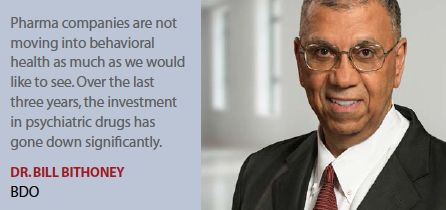 Additionally, research of psychiatric medicines is challenging. One of the challenges in neuroscience is that the diseases are diagnosed based on symptomatology using the diagnostic and statistical manual of the American Psychiatric Association, and so they’re not diagnosed based on a true understanding of the etiology, says David Nicholson, Ph.D., executive VP and president of global R&D brands at Allergan.
Additionally, research of psychiatric medicines is challenging. One of the challenges in neuroscience is that the diseases are diagnosed based on symptomatology using the diagnostic and statistical manual of the American Psychiatric Association, and so they’re not diagnosed based on a true understanding of the etiology, says David Nicholson, Ph.D., executive VP and president of global R&D brands at Allergan.
“If we don’t understand the etiology of the disorder, the true cause of the depression for example, it’s very difficult to produce an animal model that mimics the human disease," he says.
Another challenge is a high placebo response — patients on placebo who perceive an improvement in symptoms — which can mask signs of efficacy, says Robert McQuade, Ph.D., executive VP and chief strategic officer at Otsuka America Pharmaceutical Inc.
Allergan and Otsuka are two pharma companies that are committed to the area of psychiatric research, and both companies received approval for psychiatric drugs last year. Allergan’s Vraylar was approved for the treatment of schizophrenia and bipolar disorder. Otsuka’s Rexulti, co-developed with Lundbeck, was approved as an adjunctive therapy for major depressive disorder and as a treatment for schizophrenia.
Otsuka’s experience with Abilify, with partner Bristol-Myers Squibb, has helped the company to grow expertise over time. Abilify is approved to treat schizophrenia, bipolar disorder, major depressive diorder, and agitation in pediatric patients with autism.
Dr. McQuade says Rexulti works through a combination of partial agonist activity in D2 receptors, antagonist activity 5HT2 receptors, which are serotonin receptors and partial agonist activity at 5HT1a serotonin receptors.
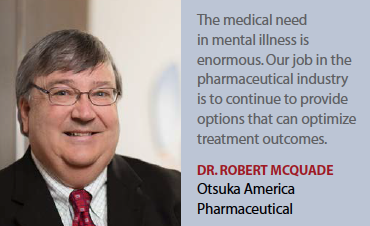 “The mechanism of action of Rexulti is qualitatively similar to that of Abilify," he says. “But quantitatively, there are differences between the two. The affinity of Rexulti for those three receptors is very similar, but more potent than the affinities that have been observed for Abilify. Quantitatively, Rexulti has a different pharmacology, which we think translates into a profile that may provide better tolerability for patients."
“The mechanism of action of Rexulti is qualitatively similar to that of Abilify," he says. “But quantitatively, there are differences between the two. The affinity of Rexulti for those three receptors is very similar, but more potent than the affinities that have been observed for Abilify. Quantitatively, Rexulti has a different pharmacology, which we think translates into a profile that may provide better tolerability for patients."
Allergan’s Vraylar modulates the activity of dopamine and, to a lesser extent, serotonin.
“Many antipsychotics are antagonists of the effects of dopamine," Dr. Nicholson says. “Vraylar, like Abilify, is a partial agonist at dopamine receptors in the brain, so that puts it into a category of a few atypical antipsychotics. Vraylar is a partial agonist with higher selectivity for the dopamine D3 receptor vs. D2 receptor."
Vraylar, Dr. Nicholson says, is effective against the positive symptoms of schizophrenia, including hallucinations.
“We think that this difference in D3 receptors contributes to Vraylar’s unique profile that we see," he says. “In one clinical study, Vraylar has also shown activity against the negative symptoms. These are symptoms of social withdrawal and an inability to interact socially, and these negative symptoms are very poorly treated by most antipsychotics. It’s these negative symptoms that make treating patients with schizophrenia difficult. We think that this profile is going to be very useful in the treatment of this terrible disease."
The other product approved in 2015 was Alkermes’ Aristada, for the treatment of schizophrenia.
Research Challenges
The real hope for psychiatric research is in academic research, Dr. Bithoney says.
“Hopefully, academic research can reveal genes, proteins, and molecules that can be labeled as drug targets in the future," he says. “Academic efforts to identify molecules, such as dopamine, that can be activated to support disease management will be helpful. Once this basic research is done, we will see more interest from drug companies."
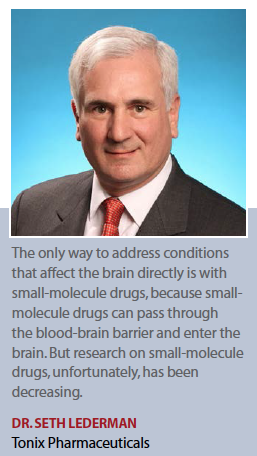 Development of new and effective treatments for mental disorders has been hindered by many factors, including a limited understanding of how current treatments work in the brain; a lack of biomarkers that help clinicians’ accurately diagnose disease, measure disease progression, and assess treatment response; and the complexity of mental disorders themselves.
Development of new and effective treatments for mental disorders has been hindered by many factors, including a limited understanding of how current treatments work in the brain; a lack of biomarkers that help clinicians’ accurately diagnose disease, measure disease progression, and assess treatment response; and the complexity of mental disorders themselves.
There is an art to the research of psychiatric medications, says Michael Murphy, M.D., Ph.D., chief medical and scientific officer at Worldwide Clinical.
“Trials have to be culturally sensitive, very patient-centered, and capable by both their design and method of execution of extracting signals out of what has occasionally been described as an ocean of noise," he says. “Additionally, developing a value proposition is very important for all indications, but especially in chronic diseases such as many of the indications in psychiatry."
Because the science may not yet be as permissive in CNS disorders in comparison with other therapeutic areas, the screening algorithms in discovery research rely heavily upon phenotypic models, Dr. Murphy says.
“Phenotypic screening paradigms currently are very sophisticated but need to demonstrate translational value in order to inform the design of studies that could be used for proof of concept in man," he says.
In this area, research strategies occasionally represent a continuation of discovery into development even after clinical trials begin, Dr. Murphy says.
“Occasionally, we are targeting a symptom, not a disease in early phase investigations," he says. “For example, we may want to confirm that the drug has a pronounced, cognitive effect along one or more dimensions, and then subsequently target an indication in which cognitive disturbances are pronounced which of necessity incorporates the perspectives of many different stakeholders."
This research strategy requires a clinical trialist to be very familiar with a portfolio of study paradigms that are ethically appropriate, maximize patient safety, and rigorous in their ability to enhance signal detection, Dr. Murphy says.
Additionally, Dr. Murphy says, it’s not uncommon for pharmaceutical researchers to consider a companion development program that uses a variety of observational research studies such as surveys or retrospective chart reviews or longitudinal cohort studies to examine different aspects of the burden of the disease or transitions in healthcare during the course of a registration program. The objective is to estimate the potential impact of novel therapy on a system of care, with particular emphasis upon healthcare utilization.
Although this strategy adds incrementally to the cost of a program, and occasionally to overall development time, it develops data that demonstrates the value of therapeutic intervention as well as its novelty.
Dr. Bithoney says research continues to be less than optimal because there is not enough specific molecular, cellular, and neurologic information to test medications properly.
“This is starting to happen," he says. “We’ve identified perhaps 100 genes or so over the last several years that relate to diseases such as autism and schizophrenia but what is still not known is how these genes interact with each other as well as at the molecular and cellular levels nor how they activate biomarkers."
Additionally, Dr. Bithoney says, there aren’t good biomarkers to indicate when someone is getting better.
“For instance, when treating a diabetic child, we can do blood tests that measure blood sugar and hemoglobin A1c levels, which can indicate whether the child is getting better," Dr. Bithoney says. “We can’t follow the same process with schizophrenia. Furthermore, the markers we use as endpoints in trials are surrogates.
“In the 1950s and 1960s, when researchers were developing the first antidepressants, in the animal models they had what they called a swim test," he explains. “They would put a rat into water and it would swim and swim. Then eventually when it got tired, the rat would just float. Research showed that by giving a rat an antidepressant it would swim actively longer and that became the proxy measure for whether an antidepressant was actually working."
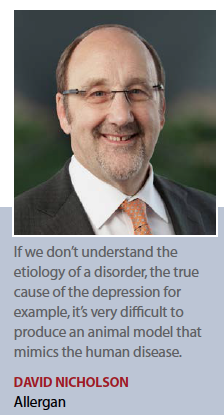 Experts say animal models for psychiatric and mental illness are limited because it’s impossible to know whether a rat is depressed, paranoid, or having delusions.
Experts say animal models for psychiatric and mental illness are limited because it’s impossible to know whether a rat is depressed, paranoid, or having delusions.
“The animal models we have are correlative," Dr. McQuade says. “There are drugs that have been developed using current models, but these models are not models of the disease. They are behavioral models that establish a correlation."
The trick, he says, is finding better animal models to advance drugs with greater confidence and efficacy.
“The problem is that we have to develop the drugs to see if they work in humans and then figure out if they work in animal models," Dr. McQuade says.
“Then we use those animal models to predict if future drugs will work. This is not a particularly innovative approach to research."
Dr. Bithoney says basic research in the psychiatric area needs animal tests that can focus on the basic molecular level as opposed to a swim test.
“I’d like to see medicines for schizophrenia that affect not only the delusions but also cognition; but we don’t have good tests to evaluate the results," he says.
Another challenge in neuroscience research is that the diseases are diagnosed based on symptomatology using the diagnostic and statistical manual of the American Psychiatric Association, Dr. Nicholson says.
“Patients are not diagnosed based on a true understanding of the etiology," he says. “When performing clinical trials, we are looking at how the symptoms are treated using a psychiatric rating scale, and with many agents in this class there is a large so-called placebo effect. Because of the placebo effect, it can be difficult to clearly demonstrate efficacy. The trials are costly, time-consuming, and there may be some failed studies even with the very effective agents."
Additionally, the endpoints used in the study of psychiatric drugs are patient reported and are subjective in nature.
“Working in an area that affects the brain, pain for example, it is an entirely subjective experience, meaning there are subjective measures," says Dr. Lederman says.
Recruiting patients and finding sites that have the appropriate staff to support ongoing CNS studies is difficult because CNS research is competitive, says Allie House, executive director within neuroscience at Worldwide Clinical.
“Patient retention is another issue," she says. “Identification of the subject is first the primary means, and we work through patient advocacy groups and different types of vendors that provide us the means to identify patients within the indication and then we work collectively with these other organizations that allow us to aid in the retention of subjects by decreasing the caregiver burden and providing transportation services and payment to subjects and caregivers."
Ms. House says working with patient/caregiver ambassadors to support patients throughout the trial is a newer trend.
“These ambassadors help to provide transportation as well as stipends to the caregivers and subjects," she says. “The benefit is that the same individual is consistent throughout the conduct of the study, which takes the onus off the site."
Current Psychiatric Drug Research
Biopharmaceutical research companies are currently developing 119 medicines to help people who have some type of mental disorder, such as anxiety, depression, schizophrenia, or substance use disorders, according to a 2014 report from the Pharmaceutical Research and Manufacturers of America. More than 75% of them are in the earliest phases of research.
For the past three decades, the therapies for psychiatric illnesses have focused on neurotransmitters such as serotonin for depression and dopamine receptor D2 for antipsychotics. Newer research is focusing on the NMDA receptor pathways, which are thought to play a role in schizophrenia, mood disorders, and psychosis.
“Psychiatric research has mainly focused on modulating the monoaminergic neurotransmitters – serotonin, dopamine, and norepinephrine, as well as GABA," Dr. Nicholson says. “More recently researchers have been looking at the modulation of glutamate excitatory amino acids and teasing apart the effect of selected modulators on different parts of the pharmacology of glutamate."
One later-stage product in development is Allergan’s Rapastinel, an intravenous formulation of a novel NMDA receptor partial agonist, which is being evaluated for adjunctive treatment of major depressive disorder. The product has shown a rapid onset of antidepressant efficacy one day after a single dose in a Phase II clinical trial of patients with MDD who had an inadequate response to one or more antidepressants. A series of Phase III registration trials are planned to begin this year.
“One of the issues with the presently available antidepressants is that they take several weeks to demonstrate efficacy, and there’s a big need for agents that have a faster onset of action," Dr. Nicholson says. “We believe that Rapastinel has promise to fulfill that need."
He says this research builds on the work that has been done with ketamine, which is a drug of abuse. Ketamine has many properties that make it difficult to become widely available as an antidepressant, but it has been shown to have a fast onset of action in several clinical studies.
“We’ve been trying to find a ketamine-like compound that doesn’t have the abuse potential, doesn’t cause hallucinations, yet does have antidepressant activity," Dr. Nicholson says. “Rapastinel could be such an agent and we’ll be moving that agent into late-stage clinical trial this year."
In the neurotransmitter research area, Tonix is conducting Phase II trials of TNX-102 SL, a potential first-in-class drug that acts upon multiple neurotransmitter systems believed to regulate sleep quality. It offers the promise to provide benefit in PTSD, including relief from sleep disturbances and nightmares. The only drugs approved for PTSD are in the SSRI class. Tonix’s product is also in Phase III trials for treating patients with fibromyalgia. In conditions that affect the brain, pain for example, the symptoms can be entirely subjective experiences, meaning that to study the activity of medicines, subjective measures need to be used. (PV)


















